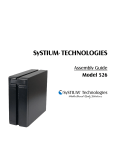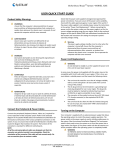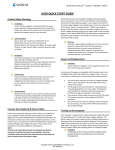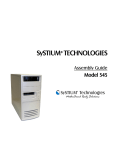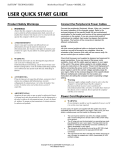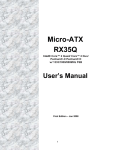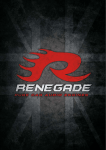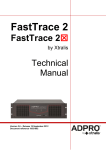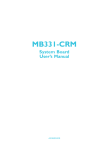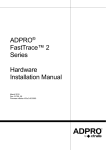Download BCM RX35Q User manual
Transcript
Assembly Guide Model 526EX 450W 80PLUS MotherBoard ReadySM System • MODEL 526EX Radio Frequency Interference Notice (USA) This equipment has been tested and found to comply with the limits for a Class B digital device, pursuant to Part 15 of the FCC Rules. These limits are designed to provide reasonable protection against harmful interference in a residential installation. This equipment generates, uses, and can radiate radio frequency energy and, if not installed and used in accordance with the instructions, may cause harmful interference to radio communications. However, there is no guarantee that interference will not occur in a particular installation. If this equipment does cause harmful interference to radio or television reception, which can be determined by turning the equipment off and on, the user is encouraged to try to correct the interference by one or more of the following measures: • • • • Reorient or relocate the receiving antenna. Increase the separation between the equipment and the receiver. Connect the equipment into an outlet on a circuit different from that to which the receiver is connected. Consult the dealer or an experienced radio/TV technician for help. Any changes or modifications not expressly approved by the grantee of this device could void the user’s authority to operate the equipment. The customer is responsible for ensuring compliance of the modified product. Only peripherals (computer input/output devices, terminals, printers, etc.) that comply with FCC class B limits may be attached to this computer product. Operation with noncompliant peripherals is likely to result in interference to radio and TV reception. All cables used to connect to peripherals must be shielded and grounded. Operation with cables, connected to peripherals that are not shielded and grounded may result in interference to radio and TV reception. Manufacturer: Systium® Technologies, LLC New Hope, MN 763-537-3600 Contact: Customer Support NOTE If a Class A device is installed within this system; then the system is to be considered a Class A system. In this configuration, operation of this equipment in a residential area is likely to cause harmful interference. Radio Frequency Interference Notice (CDN) This Class B digital apparatus complies with Canadian ICES-003. Cet appareil numérique de Ia classe B est conforme a Ia norme NMB-003 du Canada. Declaration of the Manufacturer or Importer nd This system is compliant with Low Voltage Directive 2006/95/EC using the standard EN60950-1:2006+A11, 2 Ed., (IEC60950-1:2005). This system is compliant with EU directive 2004/108/EC using the standards EN55022 and EN55024-1. Disclaimer Statement Systium® Technologies makes no warranty of any kind with regard to this material, including, but not limited to, the implied warranties of merchantability and fitness for a particular purpose. Systium Technologies assumes no responsibility for any errors that may appear in this document. Systium Technologies makes no commitment to update nor to keep current the information contained in this document. No part of this document may be copied or reproduced in any form or by any means without prior written consent of Systium Technologies. † Third-party brands and trademarks are the property of their respective owners. Copyright © 2013, Systium® Technologies, LLC PN: 91173-00 Rev 00 MotherBoard ReadySM System • MODEL 526EX ASSEMBLY GUIDE Assembly Safety Instructions Before You Begin Assembly of a computer system using this product shall be assembled only by technically qualified personnel. Follow the instructions in the document “Model 526EX Maintaining Regulatory Compliance” to meet and maintain the safety and product regulatory compliance of this product when assembling a computer system using this product. WARNINGS Read and adhere to all of these instructions and instructions supplied with this assembly. Failure to follow these instructions will result in voiding the product c regulatory compliance statements. The computer system will most likely be noncompliant with other regional product laws and regulations. The procedures in this document assume familiarity with the general terminology associated with personal computers and with the safety practices and regulatory compliance required for using and modifying electronic equipment. WARNINGS TO PREVENT ACCESS TO HIGH ELECTRICAL ENERGY PARTS, DO NOT REMOVE THE COVERS WHILE THE SYSTEM IS POWERED ON! Do not open the power supply. The power supply in this computer contains no user-serviceable parts. To avoid personal injury or damage to your equipment, refer repair or replacement of the power supply to qua 4fied technical personnel only. All other areas and components of this computer are considered user-accessible. CAUTIONS Electrostatic discharge (ESD) can damage disk drives, add-in cards, and other components. Do the procedures described in this chapter only at an ESD workstation. If such a station is not available, you can provide some ESD protection by wearing an anti-static wrist strap and attaching it to a metal part of the chassis. Add-in cards can be extremely sensitive to ESD and always require careful handling. After removing the card from its protective wrapper or from the computer, place the card flat on a grounded, static-free surface, component side up. Use a conductive foam pad (f available, but not the board wrapper Do not slide the board over any surface. For proper cooling and airflow, always close the chassis before turning on the computer system. Operating the computer system without the chassis closed can damage system parts. 1. Be sure to follow each procedure in the correct order. 2. Set up an equipment log to record the computer’s model and serial numbers, all installed options, and other information about the computer. This information must be saved as a record of the product’s configuration and compliance with the allowable configuration options. 3. We recommend that you use an anti-static wrist strap and a conductive foam pad when working on the computer. 4. You will need a Phillips (#1 and #2 bits) screwdriver and Needle Nose Pliers. NOTE The integration kit provides screws for the following: • One lock tab • One 6-32 TORX screw • Two screw-in standoffs • Four Hard Drive Mountings Screws • Eight 6-32 Phillips Screws (motherboard) • Eight M3 Phillips screws (Peripheral) • Four Fan Mounting Screws • Two Plastic Tie-wraps • Four Stick-on Rubber Feet • One Universal I/O Shield Assembly Notes for Different Motherboards The Model 526EX supports a number of different motherboards. A number of the assembly step details are different for each specific motherboard. This manual describes the steps required to complete the base system assembly task. Any steps or figures specific to a particular motherboard are noted with a reference to the assembly instructions specific to that motherboard. If no other board instructions are present, then the assembly step is consistent for all motherboards. NOTE If the manual does not include information for your specific motherboard check the Systium Technologies web site www.systium.com Tech Support for updates to this manual. Unpack the System Systium Technologies offers MotherBoard Ready products in two packaging configurations. The first is a reusable “End-User” ready single package. The second is a hi-volume bulk package. The instructions detailed are for the single package. Any differences in procedures between the single package and bulk package are noted within each section. The integration kits are the same for the single or bulk package MotherBoard Ready Systems. CAREFULLY UNPACK THE COMPUTER. Save the box and packaging material for shipment to the customer. If components are missing please contact your supplier or Systium Technologies. Copyright © 2013, Systium® Technologies, LLC PN: 91173-00 Rev 00 MotherBoard ReadySM System • MODEL 526EX BULK PACKAGE Please re-cycle the packaging. None of the bulk pack packaging is designed for reuse when shipping to the end customer. CONTENTS The Model 526EX MotherBoard Ready System product contains the following: • • • • 1. The 5.25” peripheral carrier must be removed to install the 5.25 peripheral. 2. Remove the three screws holding the 5.25” carrier to the chassis. Refer to Figure 3 3. Grasp the 5.25” carrier at the rear and pull the carrier towards the rear of the chassis. Once the carrier is separated from the chassis place it aside for installation of the 5.25” peripheral. Model 526EX Chassis with Power Supply Installed North American Compliant Power Cord Integration Kit Quickstart Guide. (This manual must be included in shipment to the End User.) Manual • Removing a Side Cover NOTE: The system covers are protected with a plastic film. This film must be removed from the top over before the unit is turned on. It is recommended that the film be left in place during assembly. 1. Remove the plastic bag protecting the chassis. Save the bag for shipping the assembled computer. 2. Remove the three screws securing the top cover to the chassis. Refer to Figure 1 3. Place a hand on each corner of the top cover. While putting pressure on your fingers use your thumb to push the chassis forward. This will cause the cover to separate from the chassis base. 4. Lift the top cover upwards and away from the chassis. Place the cover to the side where it will not get scratched or damaged before reassembly. Removing the 3.5”Peripheral Carrier 1. The 5.25” peripheral carrier screws must have been removed by completing the previous section of instructions. See Figure 3. 2. Pull back on the 3.5”carrier ejector level and release the carrier from the chassis. Once the carrier is separated from the front of the chassis the carrier can be lifted out of the chassis. See Figure 4. Place the carrier a side for installation of the 3.5” peripherals. Installing the I/O Shield (Intel BOX Motherboard) Removing the 5.25” Peripheral Carrier 1. Locate the motherboard I/O shield supplied with the Intel BOX motherboard. 2. Place the lower surface of the I/O shield in the I/O opening in the rear of the chassis. Ensure the I/O shield is fully inserted into the opening. Refer to Figure 5. NOTE: The system must have a 5.25" external peripheral installed or an EMI shield must be installed. Failure to install a 5.25" external peripheral or EMI shield can result in EMI leakage that will result in the computer system not meeting the product's EMC compliance. A 5.25" EMI shield is not supplied with the Model 526EX and must be ordered separately from Systium. Copyright © 2013, Systium® Technologies, LLC PN: 91173-00 Rev 00 MotherBoard ReadySM System • MODEL 526EX 3. 4. Carefully press the top surface of the I/O shield into the I/O opening. Be careful to only place pressure at the outer edges of the I/O shield when pressing on the I/O shield. Check that the I/O shield is fully inserted into the I/O opening. FIGURE 5 NOTE Failure to properly install the I/O shield can result in EMI leakage that will result in the computer system not meeting the product's EMC compliance. Installing a I/O Adapter (Optional) NOTE The Model 526EX system supports Motherboard with a variety of I/O bus slots. The instructions to install the adapters are the same. Care must be taken to install the adapter in the correct I/O slot. 1. 2. Remove the screw holding the I/O card hold-down bracket. Rotate the bracket away from the chassis. Refer to Figure 6 3. To remove the I/O slot cover, slide the cover upwards and away from the back of the chassis. 4. Refer to the PCI-E video adapter manual for any installation or configuration steps that need to be completed before installing the adapter into the chassis. 5. Install the I/O adapter. Refer to the motherboard manual for any motherboard specific installation instructions. 6. Rotate the I/O hold-down bracket into place to secure the I/O cards to the chassis. Secure the I/O card hold-down bracket in place by installing the screw removed in step 1. Installing the Motherboard 1. Specific Motherboard may require the installation of a screwin standoff(s) in the chassis base to mount the motherboard to. The standoff(s) are included with the integration kit. Refer to the assembly instructions for the specific motherboard being installed into the chassis. 2. Following the instructions supplied with the motherboard, install the CPU and memory. Ensure that the recommended ESD protection guidelines are followed. 3. Place the motherboard on the mounting supports. Carefully slide the motherboard towards the rear of the chassis to engage the motherboard connectors into the I/O shield openings. Refer to the assembly instructions for the specific motherboard being installed for a figure of the correct installation of the motherboard into the I/O shield. 4. Using the mounting screws supplied, mount the motherboard to the chassis. Ensure that the motherboard is fully inserted into the I/O shield while being tightened into place. 5. Connect the front panel connectors to the motherboard. Refer to the motherboard manual for the correct positions. Refer to assembly instructions for the specific motherboard being installed for a figure of the correct installation of the front panel connectors. 6. Connect the ATX power connector to the motherboard. Refer to the motherboard specific assembly instructions for any additional motherboard power connections. FIGURE 6 Removing the Front Bezel The front bezel must be removed to allow removal of the 3.5”EMI shield (if an external 3.5”device is being installed). The bezel must also be removed for installation of the front panel USB. 1. Grasp the front bezel at the outer edges. Refer to Figure 7. 2. The bezel is held on by two spring clips. Pull the bezel away from the front of the system to remove. FIGURE 7 Copyright © 2013, Systium® Technologies, LLC PN: 91173-00 Rev 00 MotherBoard ReadySM System • MODEL 526EX the shouldered 6-32 mounting screws supplied. Refer to Figure 10. Removing the Bezel Filler Panels To remove the peripheral filler panels push the mounting tabs toward each other to release the panel from the bezel. See Figure 8. FIGURE 8 FIGURE 10 Installing a 5.25” External Peripheral Removing the 3.5”EMI Shield NOTE Only when a 3.5”external peripheral is being installed should the 3.5”EMI shield be removed. Failure to install a 3.5" external peripheral can result in EMI leakage that will result in the computer system not meeting the product's EMC compliance. Remove the two screws holding the 3.5”EMI shield in place. Remove the 3.5”EMI shield. Refer to Figure 9. NOTE The system must have one 5.25" external peripheral installed or an EMI shield must be installed. Failure to install a 5.25" external peripheral or EMI shield can result in EMI leakage that will result in the computer system not meeting the product's EMC compliance. 1. 2. FIGURE 9 3. If the 5.25” carrier is not already removed you must remove it. To remove the 5.25” carrier following the instructions in the section “Removing the 5.25”Peripheral Carrier”. Configure any jumpers or switch settings required by the peripheral. Refer to the peripheral's user manual for specific instructions. Position the peripheral in the 5.25 carrier as shown in Figure 11. Line up the peripheral mounting holes with the carrier mountings holes marked with a “3”. Using the supplied M3 screws, attach the peripheral to the carrier. FIGURE 11 Installing a Second 3.5” Hard Drive Part Number 52635-00 1. Installing a 3.5” Peripheral (Hard Drive) 1. 2. 3. If the 3.5” carrier is not already removed you must remove it. To remove the 3.5” carrier following the instructions in the section “Removing the 3.5”Peripheral Carrier”. Configure any jumpers or switch settings required by the peripheral. Refer to the peripheral's user manual for specific instructions. Insert the 3.5” peripheral (HD Shown) into the carrier. The power and signal connectors should be oriented towards the rear of the chassis once the carrier is installed. Align the 3.5” peripheral mounting screws with the mounting holes in the carrier marked HD. Secure the peripheral to the carrier using 2. If the 5.25” carrier is not already removed you must remove it. To remove the 3.5” carrier following the instructions in the section “Removing the 5.25”Peripheral Carrier”. The second HD carrier must be attached to the 5.25 peripheral carrier before the HD is installed. Refer to Figure 12. FIGURE 12 Copyright © 2013, Systium® Technologies, LLC PN: 91173-00 Rev 00 MotherBoard ReadySM System • MODEL 526EX 3. Position the second HD carrier such that the mounting tabs locking into the mounting locations on the 5.25 peripheral carrier. Secure the second HD carrier to the 5.25 peripheral carrier using the two supplied screws. Refer to Figure 13. FIGURE 13 Connect Peripheral Cables 1. 2. 3. 4. Connect the SATA or IDE HD cable to the hard drive. Route the cable along the bottom of the drive towards the front of the chassis. Connect the floppy cable to the floppy. The route the cable over the HD cable and directly to the other board. Attached the floppy cable to the motherboard. Connect the SATA or IDE HD cable to the motherboard. Route the cable over top the floppy cable. Connect the IDE cable for the 5.25” peripheral to the secondary IDE connector on the motherboard. Fold the cable into a flat bundle to shorten up the cable. Position the drive end of the cable to the rear of the chassis. Install the 5.25”Peripheral Carrier 4. 5. Configure any jumpers or switch settings required by the peripheral. Refer to the peripheral's user manual for specific instructions. Insert the 3.5” peripheral (HD Shown) into the carrier. The power and signal connectors should be oriented towards the rear of the chassis once the carrier is installed. Align the 3.5” peripheral mounting screws with the mounting holes in the carrier marked HD. Secure the peripheral to the carrier using the shouldered 6-32 mounting screws supplied. Refer to Figure 14. 1. 2. 3. Lower the 5.25” carrier into the chassis and insert the carrier into the 5.25” opening in the front of the chassis. . The carrier must fit inside the 5.25” chassis opening flanges. See figure 16. Line up the three mounting holes on the carrier with the corresponding holes in the chassis. The mounting flange at the side of the carrier is mounted on top of the 3.5” carrier mounting tab. See Figure 16. Connect the IDE cable to the 5.25 peripheral. See Figure 16. FIGURE 14 FIGURE 16 Install the 3.5”Peripheral Carrier 1. 2. 3. The 3.5” peripheral carrier is mounted in the chassis by two guide rails and a mounting tab. The carrier must also fit inside the 3.5” chassis opening flanges. See figure 15. Lower the carrier into the chassis such that the carrier is held between the two guides. Slide the carrier forwards to position the floppy correctly in the 3.5” chassis opening. Push the carrier forward until the ejector level latches into place. FIGURE 15 Connect the Peripheral Power Cables Connect the peripheral power cables as required. Route the cables so that there is no cables passing over top the CPU cooling fan. Use the tie-wraps included in the integration kit to secure the cables together to ensure clean routing. Install Cover Lock Tab NOTE The Model 526EX utilizes a power supply with an Energy Hazard on the 12V circuit. Compliance with CE requires installation of the cover lock tab and a lock or the use of the 6-32 TORX screw to secure the top cover. 1. Locate the locking tab and mounting screw in the accessory package. 2. Position the locking tab in the notch in the power supply side of the back of the chassis. Secure the locking tab to the chassis using the screw supplied. Refer to Figure 17. Copyright © 2013, Systium® Technologies, LLC PN: 91173-00 Rev 00 MotherBoard ReadySM System • MODEL 526EX FIGURE 17 The Model 526EX utilizes a power supply with an Energy Hazard on the 12V circuit. Compliance with CE requires installation of the cover lock tab and a lock or the use of the 6-32 TORX screw supplied to secure the top cover. Install the Chassis Feet - Desktop 1. Install the Front USB Module (Optional) NOTE Perform this assembly step if the system requires the front USB ption installed. 2. 3. 1. 2. 3. 4. 5. Remove the front bezel. Refer to the previous section” Removing the Front Bezel” for instructions. Locate the front USB access cover. Remove the access cover by inserting a flat screwdriver into the cover and flexing it until the cover breaks away from the chassis. See Figure 18. Remove the front USB module part # 52526-01C from the box. Using the screws supplied with the USB module, secure the USB module to the front of the chassis. See Figure 18. Using the cable supplied with the front USB module connect the USB module to the motherboard. Refer to the instructions supplied with the motherboard for the front panel USB connector. Remove the USB filler panel from the bezel. Refer to Figure 8. Reinstall the bezel. Line up the bezel mounting clips and push the bezel towards the chassis to engage the mounting clips. Turn the unit upside down. Place the unit on a surface that will not scratch the top cover. Place the template supplied in the accessory kit in one of the corners of the bottom surface of the computer. Refer to Figure 19. Remove the paper backing from the rubber foot and install the foot sticky side down into the circular opening in the template. Press on the foot to make sure it attaches firmly to the bottom of the computer. Refer to Figure 19. Repeat steps 1 & 2 to install the other three feet. Turn the computer over and remove the protective cover from the top cover. FIGURE 19 Install the Chassis Feet - Tower 1. 2. 3. FIGURE 18 4. Remove the protective cover from the top cover. Turn the computer such that the I/O card end of the computer is at the top. Place the unit on a surface that will not scratch the cover. Place the template supplied in the accessory kit in one of the corners of the bottom surface of the computer. Refer to Figure 19. Remove the paper backing from the rubber foot and install the foot sticky side down into the circular opening in the template. Press on the foot to make sure it attaches firmly to the bottom of the computer. Refer to Figure Repeat steps 2 & 3 to install the other three feet. Install the Top Cover NOTE Before installing the top side cover please check that all cables are connected and no tools, screws or accessories are left inside the chassis. 1. 2. Position the cover down on top of the chassis about 1 inch away to the rear of where the cover’s finally closed position. Slide the cover forward to engage the cover locking tabs to the chassis. Attached the cover to the chassis using the three screws used to initially secure the cover to the chassis. See Figure 1. NOTE Copyright © 2013, Systium® Technologies, LLC PN: 91173-00 Rev 00 MotherBoard ReadySM System • MODEL 526EX Power up the System 1. 2. 3. 4. Connect the keyboard, mouse, monitor and any other required peripheral for the correct operation of the computer. Refer to the Model Guide for assistance in connecting the peripherals to the computer. Turn on the computer by pressing the power switch on the front panel. Refer to the Quick Start Section of this manual for more information. Verify the operation of the POWER ON indicator on the front panel. The LED should glow constantly when the computer is turned on. Verify that the floppy LED turns on when the system resets the floppy drive during the POST. Verify the operation of the hard drive LED on the front panel. The LED should turn on when the POST resets the hard drive or attempts to boot the computer. Correct any problems detected during the initial power up phase. Test the complete operation of the computer using a known good computer functional test program such as Intel’s Test view. Install any required operating system or application software. NOTE The computer must have all the required warning and information lights functioning before shipping to the end user. 5. Disconnect the computer from the peripherals used during the testing phase. Package the computer using the original packaging. NOTE You must include the End User Quick Start manual in the shipment to the customer to maintain Regulatory Compliance. Copyright © 2013, Systium® Technologies, LLC PN: 91173-00 Rev 00 ® SySTIUM TECHNOLOGIES MOTHERBOARD READY SM SYSTEM • MODEL 526EX Advantech AIMB-567 ASSEMBLY INSTRUCTIONS I/O Shield Installation of front panel connectors The Advantech AIMB-567 motherboard uses the Advantech I/O shield supplied with the motherboard. Refer to the main assembly guide for instructions on installing the I/O shield. Installing the Motherboard STANDOFF INSTALLATION 1. Install the standoff, (if required) included in the chassis integration kit, in location 0 as shown in the figure below. Connect Peripheral Cables Refer to the Model 526 Assembly Guide for the suggested peripheral cable routing. HEATSINK INSTALLATION 1. Install the CPU fan heatsink per instructions provided with the Intel Box set. 2. Connect the heatsink fan power cable to the motherboard. Copyright © 2013, Systium® Technologies, LLC 526EX AIMB-567 AI Rev 1.0 ® SySTIUM TECHNOLOGIES MOTHERBOARD READY SM SYSTEM • MODEL 526EX Advantech AIMB-580 ASSEMBLY INSTRUCTIONS motherboard. I/O Shield The Advantech AIMB-580 motherboard uses the Advantech I/O shield supplied with the motherboard. Refer to the main assembly guide for instructions on installing the I/O shield. Installation of front panel connectors Stand Off Installing the Motherboard Connect Peripheral Cables STANDOFF INSTALLATION 1. Install the standoff, (if required) included in the chassis integration kit, in location 0 as shown in the figure below. Refer to the Model 526 Assembly Guide for the suggested peripheral cable routing. HEATSINK INSTALLATION 1. Install the CPU fan heatsink per instructions provided with the Intel Box set. 2. Connect the heatsink fan power cable to the Copyright © 2013, Systium® Technologies, LLC 526EX AIMB-580 AI Rev 1.0 ® SySTIUM TECHNOLOGIES MOTHERBOARD READY SM SYSTEM • MODEL 526EX BCM RX35Q ASSEMBLY INSTRUCTIONS I/O Shield Installation of front panel connectors The BCM RX35Q motherboard uses the BCM I/O shield supplied with the motherboard. Refer to the main assembly guide for instructions on installing the I/O shield. Installing the Motherboard STANDOFF INSTALLATION 1. Install the standoff, (if required) included in the chassis integration kit, in location 0 as shown in the figure below. Connect Peripheral Cables Refer to the Model 526E Assembly Guide for the suggested peripheral cable routing. HEATSINK INSTALLATION 1. Install the CPU fan heatsink per instructions provided with the Intel Box set. 2. Connect the heatsink fan power cable to the motherboard. Copyright © 2013, Systium® Technologies, LLC 526EX RX35Q AI Rev 1.0 ® SySTIUM TECHNOLOGIES MOTHERBOARD READY SM SYSTEM • MODEL 526EX BCM RX45Q ASSEMBLY INSTRUCTIONS I/O Shield The BCM RX45Q motherboard uses the BCM I/O shield supplied with the motherboard. Refer to the main assembly guide for instructions on installing the I/O shield. Installation of front panel connectors Installing the Motherboard STANDOFF INSTALLATION 1. Install the standoff, (if required) included in the chassis integration kit, in location 0 as shown in the figure below. Connect Peripheral Cables Refer to the Model 526E Assembly Guide for the suggested peripheral cable routing. HEATSINK INSTALLATION 1. Install the CPU fan heatsink per instructions provided with the Intel Box set. 2. Connect the heatsink fan power cable to the motherboard. Copyright © 2013, Systium® Technologies, LLC 526EX RX45Q AI Rev 1.0 ® SySTIUM TECHNOLOGIES MOTHERBOARD READY SM SYSTEM • MODEL 526EX BCM RX67QV ASSEMBLY INSTRUCTIONS I/O Shield The BCM RX67Q motherboard uses the BCM I/O shield supplied with the motherboard. Refer to the main assembly guide for instructions on installing the I/O shield. Installation of front panel connectors Installing the Motherboard STANDOFF INSTALLATION 1. Install the standoff, (if required) included in the chassis integration kit, in location 0 as shown in the figure below. Connect Peripheral Cables Refer to the Model 526E Assembly Guide for the suggested peripheral cable routing. HEATSINK INSTALLATION 1. Install the CPU fan heatsink per instructions provided with the Intel Box set. 2. Connect the heat sink fan power cable to the motherboard. Copyright © 2013, Systium® Technologies, LLC 526EX RX67Q AI Rev 1.0 ® SySTIUM TECHNOLOGIES MOTHERBOARD READY SM SYSTEM • MODEL 526EX BCM RX965QV ASSEMBLY INSTRUCTIONS I/O Shield The BCM RX67Q motherboard uses the BCM I/O shield supplied with the motherboard. Refer to the main assembly guide for instructions on installing the I/O shield. Installation of front panel connectors Installing the Motherboard STANDOFF INSTALLATION 1. Install the standoff, (if required) included in the chassis integration kit, in location 0 as shown in the figure below. Connect Peripheral Cables Refer to the Model 526E Assembly Guide for the suggested peripheral cable routing. HEATSINK INSTALLATION 1. Install the CPU fan heatsink per instructions provided with the Intel Box set. 2. Connect the heatsink fan power cable to the motherboard. Copyright © 2013, Systium® Technologies, LLC 526EX RX965QV AI Rev 1.0 ® SySTIUM TECHNOLOGIES MOTHERBOARD READY SM SYSTEM • MODEL 526EX INTEL DH55TC ASSEMBLY INSTRUCTIONS . I/O Shield Installation of front panel connectors The Intel DH55TC motherboard uses the Intel I/O shield supplied with the motherboard. Refer to the main assembly guide for instructions on installing the I/O shield. Installing the Motherboard STANDOFF INSTALLATION 1. Install the standoff, included in the chassis integration kit, in location 0 as shown in the figure below. HEATSINK INSTALLATION 1. Install the CPU fan heatsink per instructions provided with the Intel Box set. 2. Connect the heatsink fan power cable to the motherboard. 3. Turn the motherboard over while holding the support bracket in place. Place the new heat sink mount on the motherboard. Attach the heat sink using the 4 built-in screws. 4. Connect the heat sink fan power cable to the motherboard. Copyright © 2013, Systium® Technologies, LLC 526EX DH55TC AI Rev 1.0 ® SySTIUM TECHNOLOGIES MOTHERBOARD READY SM SYSTEM • MODEL 526EX INTEL DQ67OW ASSEMBLY INSTRUCTIONS Installation of front panel connectors I/O Shield The Intel DQ67OW motherboard uses the Intel I/O shield supplied with the motherboard. Refer to the main assembly guide for instructions on installing the I/O shield. Installing the Motherboard STANDOFF INSTALLATION 1. Install the standoff, included in the chassis integration kit, in location 0 as shown in the figure below. HEATSINK INSTALLATION 1. Install the CPU fan heatsink per instructions provided with the Intel Box set. 2. Connect the heatsink fan power cable to the motherboard. 3. Turn the motherboard over while holding the support bracket in place. Place the new heat sink mount on the motherboard. Attach the heat sink using the 4 built-in screws. 4. Connect the heat sink fan power cable to the motherboard. Copyright © 2013, Systium® Technologies, LLC 526EX DQ67OW AI Rev 1.0 ® SySTIUM TECHNOLOGIES MOTHERBOARD READY SM SYSTEM • MODEL 526EX INTEL DQ67SW ASSEMBLY INSTRUCTIONS I/O Shield The Intel DQ67SW motherboard uses the Intel I/O shield supplied with the motherboard. Refer to the main assembly guide for instructions on installing the I/O shield. Installation of front panel connectors Installing the Motherboard STANDOFF INSTALLATION 1. Install the standoff, included in the chassis integration kit, in location 0 as shown in the figure below. HEATSINK INSTALLATION 1. Install the CPU fan heatsink per instructions provided with the Intel Box set. 2. Connect the heatsink fan power cable to the motherboard. 3. Turn the motherboard over while holding the support bracket in place. Place the new heat sink mount on the motherboard. Attach the heat sink using the 4 built-in screws. 4. Connect the heat sink fan power cable to the motherboard Copyright © 2013, Systium® Technologies, LLC 526EX DQ67SW AI Rev 1.0 ® SySTIUM TECHNOLOGIES MOTHERBOARD READY SM SYSTEM • MODEL 526EX INTEL DQ77MK ASSEMBLY INSTRUCTIONS I/O Shield Installation of front panel connectors The Intel DQ77MK motherboard uses the Intel I/O shield supplied with the motherboard. Refer to the main assembly guide for instructions on installing the I/O shield. Installing the Motherboard STANDOFF INSTALLATION 1. Install the standoff, included in the chassis integration kit, in location 0 as shown below. HEATSINK INSTALLATION 1. Install the CPU fan heatsink per instructions provided with the Intel Box set. 2. Connect the heatsink fan power cable to the motherboard. 3. Turn the motherboard over while holding the support bracket in place. Place the new heat sink mount on the motherboard. Attach the heat sink using the 4 built-in screws. 4. Connect the heat sink fan power cable to the motherboard. Copyright © 2013, Systium® Technologies, LLC 526EX DQ77MK AI Rev 1.0 ® SySTIUM TECHNOLOGIES MOTHERBOARD READY SM SYSTEM • MODEL 526EX ITOX BL330-BR ASSEMBLY INSTRUCTIONS 3. I/O Shield Turn the motherboard over while holding the support bracket in place. Place the new heat sink mount on the motherboard. Attach the heatsink using the 4 built-in screws. See Figure 2. The ITOX BL330-BR motherboard uses the I/O shield supplied with the motherboard. Refer to the main assembly guide for instructions on installing the I/O shield. FIGURE 2 Installing the Motherboard STANDOFF INSTALLATION 1. Install the standoff, included in the chassis integration kit, in location 0 as shown in the figure below. 4. Connect the heatsink fan power cable to the motherboard. Refer to Figure 2. INSTALLATION OF FRONT PANEL CONNECTORS HEATSINK INSTALLATION 1. 2. Install the CPU following the instructions provided with the CPU. Insert the heat sink support bracket into the motherboard from the underside of the motherboard. The standoffs on the bracket are inserted into the holes in the motherboard. Refer to Figure 1. NOTE Make sure the top surface of the heat sink support bracket has the mylar insulator. Failure to have the insulator in place will result in the board not working. FIGURE 1 Connect Peripheral Cables Refer to the Model 526 Assembly Guide for the suggested peripheral cable routing. Copyright © 2013, Systium® Technologies, LLC 526EX BL330-BR AI Rev 1.0 ® SySTIUM TECHNOLOGIES MOTHERBOARD READY SM SYSTEM • MODEL 526EX ITOX EL330-DR ASSEMBLY INSTRUCTIONS I/O Shield 3. The ITOX EL330-DR motherboard uses the I/O shield supplied with the motherboard. Refer to the main assembly guide for instructions on installing the I/O shield. Turn the motherboard over while holding the support bracket in place. Place the new heat sink mount on the motherboard. Attach the heatsink using the 4 built-in screws. See Figure 2. FIGURE 2 Installing the Motherboard STANDOFF INSTALLATION 1. Install the standoff, included in the chassis integration kit, in location 0 as shown in the figure below. 4. Stand Off Connect the heatsink fan power cable to the motherboard. Refer to Figure 2. INSTALLATION OF FRONT PANEL CONNECTORS HEATSINK INSTALLATION 1. 2. Install the CPU following the instructions provided with the CPU. Insert the heat sink support bracket into the motherboard from the underside of the motherboard. The standoffs on the bracket are inserted into the holes in the motherboard. Refer to Figure 1. NOTE Make sure the top surface of the heat sink support bracket has the mylar insulator. Failure to have the insulator in place will result in the board not working. FIGURE 1 Connect Peripheral Cables Refer to the Model 526E Assembly Guide for the suggested peripheral cable routing. Copyright © 2013, Systium® Technologies, LLC 526EX EL330-DR AI Rev 1.0 ® SySTIUM TECHNOLOGIES MOTHERBOARD READY SM SYSTEM • MODEL 526EX ITOX MB330-CRM ASSEMBLY INSTRUCTIONS I/O Shield Installation of front panel connectors The ITOX MB330-CRM motherboard uses the I/O shield supplied with the motherboard. Refer to the main assembly guide for instructions on installing the I/O shield. Installing the Motherboard STANDOFF INSTALLATION • Install the standoff, included in the chassis integration kit, in location 0 as shown in the figure below. HEATSINK INSTALLATION • • • Install the CPU following the instructions provided with the CPU. Insert the heat sink support bracket into the motherboard from the underside of the motherboard. Connect the heat sink fan power cable to the motherboard. Copyright © 2013, Systium® Technologies, LLC 526EX MB330-CRM AI Rev 1.0 ® SySTIUM TECHNOLOGIES MOTHERBOARD READY SM SYSTEM • MODEL 526EX ITOX SB330-CRM ASSEMBLY INSTRUCTIONS I/O Shield Installation of front panel connectors The ITOX SB330-CRM motherboard uses the I/O shield supplied with the motherboard. Refer to the main assembly guide for instructions on installing the I/O shield. Installing the Motherboard STANDOFF INSTALLATION • Install the standoff, included in the chassis integration kit, in location 0 as shown in the figure below. HEATSINK INSTALLATION • • • Install the CPU following the instructions provided with the CPU. Insert the heat sink support bracket into the motherboard from the underside of the motherboard. Connect the heat sink fan power cable to the motherboard. Copyright © 2013, Systium® Technologies, LLC 526EX MB331-CRM AI Rev 1.0 ® SySTIUM TECHNOLOGIES MOTHERBOARD READY SM SYSTEM • MODEL 526EX ITOX SB330-CRM ASSEMBLY INSTRUCTIONS I/O Shield Installation of front panel connectors The Itox SB330-CRM motherboard uses the Intel I/O shield supplied with the motherboard. Refer to the main assembly guide for instructions on installing the I/O shield. Installing the Motherboard STANDOFF INSTALLATION 1. Install the standoff, included in the chassis integration kit, in location 0 as shown in the figure below. HEATSINK INSTALLATION 1. Install the CPU fan heatsink per instructions provided with the Intel Box set. 2. Connect the heatsink fan power cable to the motherboard. 3. Turn the motherboard over while holding the support bracket in place. Place the new heat sink mount on the motherboard. Attach the heat sink using the 4 built-in screws. 4. Connect the heat sink fan power cable to the motherboard. Copyright © 2013, Systium® Technologies, LLC 526EX SB330-CRM AI Rev 1.0 MODEL 526EX MAINTAINING REGULATORY COMPLIANCE WARNING Read and adhere to all of these instructions supplied for the Model 526EX system. Failure to follow these instructions will result in voiding the product’s regulatory compliance statements. Note that the computer system may be noncompliant with other regional product laws and regulations. Critical Components: To maintain the Model 526EX CSA listing and Model 526EX compliance to other regulatory certifications and/or declarations the following Critical Components must be used. The Model 526EX product is a Critical Component. The SySTIUM® Model 526EX must be used without modification to the cooling fans or the chassis enclosure. The power supplies listed below are included with the Model 526EX. Any Model 526EX power supply substitution or modification will invalidate the Model 526EX regulatory compliance. One of the motherboards listed in the table below must be used with the Model 526EX. Use of any other motherboard will invalidate the Model 526EX regulatory compliance. The integrator must use the heat sink listed as required to ensure regulatory compliance. The table below was constructed using a CPU no greater than 95W TDP. Using a higher wattage CPU will invalidate the Model 526EX regulatory compliance. MFG Motherboard Intel DG41TY Intel DH55TC Intel DQ67SW Intel DQ77MK Advantech AIMB-580 Advantech AIMB-567 BCM RX35Q BCM RX965QV BCM RX45Q BCM RX67Q ITOX BL330-BR ITOX EL330-DR ITOX MB330-CRM ITOX ITOX MB331-CRM SB330-CRM Notes Power Supplies ST-450SFX ST-450SFX ST-450SFX ST-450SFX Heat Sink Required SySTIUM 10304-00C or 10312-25 All CPU’s to: Intel Supplied 3.4GHz SySTIUM 10312-25 3.4GHz SySTIUM 10312-25 3.4GHz ST-450SFX SySTIUM 10312-25 ST-450SFX SySTIUM 10304-00C or 10312-25 SySTIUM 10304-00C or 10312-25 SySTIUM 10304-00C or 10312-25 SySTIUM 10304-00C or 10312-25 SySTIUM 10312-25 ST-450SFX ST-450SFX ST-450SFX ST-450SFX ST-450SFX ST-450SFX ST-450SFX ST-450SFX ST-450SFX SySTIUM 10304-00C or 10312-25 SySTIUM 10304-00C or 10312-25 SySTIUM 10304-00C or 10312-25 SySTIUM 10304-00C or 10312-25 SySTIUM 10304-00C or 10312-25 3.33 GHz 3.4GHz 3.4GHz 3.4GHz 3.8GHz 3.4GHz 3.4GHz 3.4GHz 3.4GHz 3.4GHz 3.4GHz 3.4GHz Optional Components: In addition to the required Critical Components listed above Optional Components may be integrated by the assembler/integrator. Optional Components include peripherals (HDD, SSD, optical drives, etc.) and add in /add-on adapters (PCI, PCI-e, USB devices, etc.). The assembler/integrator assumes responsibility for ensuring the Optional Components meet Model 526EX regulatory compliance. ADAPTERS The Model 526EX is designed to support only half-length PCI or PCI-e adapters. Installed adapters must be CSA, UL or TUV Listed or Recognized, FCC Class B compliant and CE Marked. PERIPHERALS Installed peripherals must be CSA, UL or TUV Listed or Recognized, FCC Class B compliant and CE Marked. NOTE: If a Class A device is installed within this system, then the system is considered a Class A system with respect to the FCC and CE certification. Copyright © 2013, SySTIUM® Technologies, LLC PN: 91608-00 Rev00 1 NOTE: Effective January 1, 2013 the CE Mark also includes Environmental Conformance Requirements (RoHSII). SySTIUM® maintains a RoHSII technical file for the Model 526EX (and any Critical Component or Optional Component supplied by SySTIUM®) The SySTIUM® Technical File is available upon request and signed NDA. The assembler/integrator assumes responsibility to maintain a CE compliant technical file on all Critical Components and on all Optional Components that were integrated into the Model 526EX to ensure compliance with the CE mark. NOTE: The information documented above is updated as required on the SySTIUM® Website (www.SySTIUM.com). Please check the website for information on new supported Critical Components and/or processor speeds. Validating Power Budget – It is the responsibility of the assembler/integrator to validate that the Model 526EX maximum power budget is not being exceeded. The computer’s assembled configuration maximum power load cannot exceed the safety certification configuration maximum power load. Note that the power supply’s output ratings are higher than the Model 526EX system safety certification ratings. Customer configurations must be checked to ensure that the system’s safety certification loads are not exceeded; otherwise the CSA safety certification is null and void. The power calculation table is provided below to assist in verifying that the assembled system remains compliant with the Model 526EX maximum power load configuration to maintain CSA safety certification. It is recommended that a copy of the filled out table be filled with the assembly plan for the configuration and be available for CSA safety inspection when necessary. NOTE: It the assemblers/integrators responsibility to determine and validate the amperage and power ratings of any Optional Components (Add-in PCI / PCIe / USB loads and verify that they fall within the Add-In Total Load line item provided. The 72W, 12V portion of the add-in total load is sufficient for most add-in video cards. The final system configuration’s power budget must fall within the Safety Maximum to maintain compliance. 450W supply – EXAMPLE POWER BUDGET – CONFORMING TO THE SAFETY MAXIMUMS DEVICE MAX WATTAGE 12V A 5V A 3.3V A 5V sb A OPTICAL DRIVE 25.5 1.5 1.5 0 0 HDD 1 12.75 0.75 0.75 0 0 HDD2 12.75 0.75 0.75 0 0 CPU 96 8 0 0 0 MB / MEM / FAN(s) 46 1.5 4 2 0.25 Add-in PCI/PCIex/USB Total Load 129.45 6 5.3 9 0.25 System Total – PSU MAX Per SAFETY CERTIFICATION 322.45 18.5 12.3 11 0.5 NOTE The peripheral power ratings are typically listed on the product identification label on the peripheral. The manufacturer’s specifications are another source of this information. The load wattage is determined by multiplying the peripheral supply voltage by the peripheral’s maximum current draw for that voltage. For dual voltage peripherals the total load wattage is the sum of each supply voltage’s wattage. NOTE Use Only for Intended Applications This product was evaluated as Information Technology Equipment (ITE) that may be installed in offices, homes and similar locations. The use of this product for other Product Safety Categories or Environments other than ITE may require further evaluation. Examples of other Product Safety Categories are Medical Instrumentation or Control and Test Equipment. Check with your Local Product Safety Agency for further information. Copyright © 2013, SySTIUM® Technologies, LLC PN: 91608-00 Rev00 2 REGULATORY INFORMATION A computer system, when correctly configured and assembled as instructed in this document, meets the following safety and EMC regulations. SAFETY COMPLIANCE UL 60950-1 Second Edition; CSA60950-1-07 Second Edition Amendment 1:2011 Information Technology Equipment - Safety - Part 1: General Requirements EN 60950- 1:2006/A11:2009/A1:2010/A12:2011; The Standard for Safety of Information Technology Equipment including Electrical Business Equipment. (European Union) “EN 60950 compliance” IEC 60950-1:2005 (2nd Edition); Am 1:2009 The Standard for Safety of Information Technology Equipment including Electrical Business Equipment. (International) EMC COMPLIANCE FCC Class B Title 47 of the Code of Federal Regulations, Parts 2 & 15, Subpart B, pertaining to unintentional radiators. (USA) “EMI regulations” “FCC compliance” CISPR 22; 2009+A1:2010 Limits and methods of measurement of Radio Interference Characteristics of Information Technology Equipment. (International) “CISPR 22compliance” EN 55022:2010 Limits and methods of measurement of Radio Interference Characteristics of Information Technology Equipment. (Europe) “EN 55022 compliance” EN 55024:2010 ITE Immunity Standard; ICES-003:2012 Interference-Causing Equipment Standard, Digital Apparatus. (Canada) ENVIRONMENTAL COMPLIANCE RoHSII Directive 2011/65/EU Copyright © 2013, SySTIUM® Technologies, LLC PN: 91608-00 Rev00 3



























